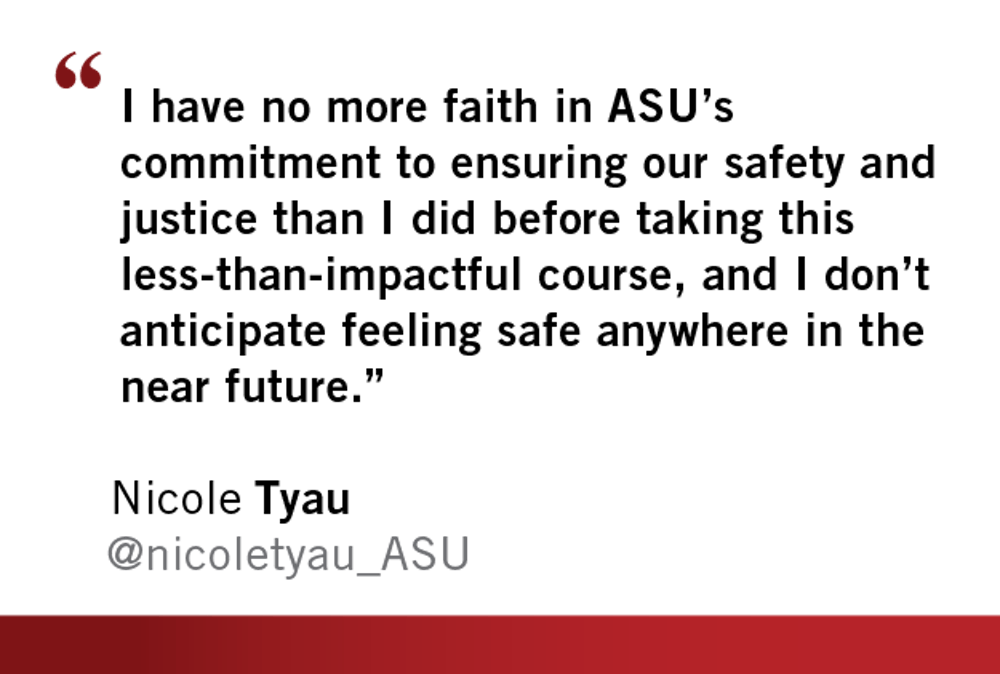As a Barrett sophomore, the rumors of sexual misconduct between honors faculty and students have been circulating since I first began attending the honors college. Recently, the Phoenix New Times published a very in-depth story detailing the torrid affairs and the University’s response. This story comes in the wake of ASU’s appearance on the list of universities being investigated for violation of the Title IX sexual misconduct response.
 ASU responded by creating a University-wide required Consent and Respect course. Without a doubt, this course will do nothing to combat rape culture at ASU.
ASU responded by creating a University-wide required Consent and Respect course. Without a doubt, this course will do nothing to combat rape culture at ASU.
The course covers subjects in three parts: facts about rape, ranging from the definition of consent to statistics of rape victims; risk reduction strategies, which tell you how not to get raped and how not to let others get raped; and what you and the university can do for someone who experiences sexual violence or rape. Throughout each section, you are quizzed with facts from the lessons and statistics.
There are numerous problems with this course.
In the first section, that statistics can basically be summarized as, “You’re a female undergrad student? Congratulations, you’ve got a 25 percent chance of being raped before you graduate” and that “Anyone can be a victim of sexual violence.” While important, these statements don’t tell the full story.
One in Four is a nonprofit advocacy group for the “prevention of rape by the thoughtful application of theory and research to rape prevention programming.” In their extensive statistics, it’s mentioned that in 60 percent of college rapes, the perpetrator is a friend of the victim, while only 32 percent are committed by a significant other and a mere 8 percent are strangers. Consent and Respect reports that 50 percent of rapes happen on a date; it fails to highlight that sexual assault victims must be wary even with a person they believe can be trusted.
The course also tries to give instruction about stopping sexual assault by gauging the situation and acting accordingly. The course recommends that you “consider if you can act alone or need help, determine the lowest-risk option for intervening, (and) decide when and how to act.” This is an extremely vague answer. The lowest-risk option will always be to let the professionals handle it by calling 911, but that method won’t always stop the sexual assault immediately. The only solutions the course offers are “good examples” of how a bystander can intervene. When asked how she would react if she saw a couple arguing and one getting slapped by the other, a respondent identified as Brooke said, “I feel like I would be with other people and we’d all be like, ‘Wow! We should do something about that.’” This response doesn’t give you a clear sense of whether or not you should intervene. In other questions, the interviewers ask about what students would do if they saw someone “(put) something” in a drink or how they would react to an “intoxicated male” trying to get an uninterested female to have sex with him; all respondents say to intervene with one of the parties. The National Council on Alcoholism and Drug Dependence reports that 40 percent of violent crimes have alcohol as a contributing factor. With this link, it doesn’t seem logical to me to encourage untrained students to intervene so directly in an unpredictable and potentially dangerous situation.
Perhaps my biggest problem with this education is that it taught me nothing of what ASU is doing to better adhere to the Title IX statement to “(address) issues involving sex discrimination, including sexual violence.” The violation isn’t about students not reporting their cases, but ASU not investigating these cases. In a statement from ASU President Michael Crow, he establishes a new task force that “will review our current policies and practices, strengthen our education and awareness efforts, enhance existing and forge new partnerships with key organizations and agencies and review and recommend support services and resources for victims of sexual misconduct.” While the Title IX allegations are still unproven, I am uneasy that Crow has not assured the ASU community that all claims of sexual violence will be investigated. I have no more faith in ASU’s commitment to ensuring our safety and justice than I did before taking this less-than-impactful course, and I don’t anticipate feeling safe anywhere in the near future.
Reach the columnist at nicole.tyau@asu.edu or follow @nicoletyau_ASU on Twitter.
Editor’s note: The opinions presented in this column are the author’s and do not imply any endorsement from The State Press or its editors.
Want to join the conversation? Send an email to opiniondesk.statepress@gmail.com. Keep letters under 300 words and be sure to include your university affiliation. Anonymity will not be granted.
Like The State Press on Facebook and follow @statepress on Twitter.




